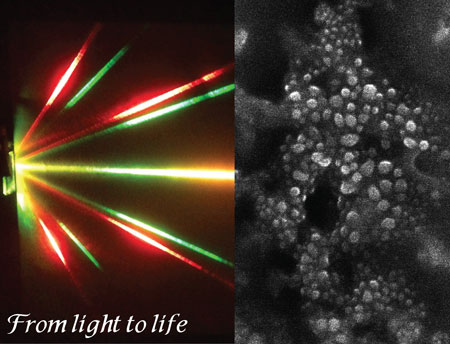| Posted: Mar 25, 2013 | |
'Taking a photo' of DNA helices with an Environmental Scanning Electronic Microscope |
|
| (Nanowerk Spotlight) Applications and studies in DNA-based biophysics, biochemistry and biotechnology rely on accurate imaging with high temporal and spatial resolution towards the mesoscopic and single-molecule levels. This, in turn, relies on the ability to immobilize and stretch portions of DNA on a substrate without damaging it. The high-energy electron beam needed to magnify a piece of the DNA helix with scanning electron microscopy, for instance, would be of such high energy that it would cause the DNA under inspection to be removed from the support structure or simply evaporated. | |
| A research team at the University of Calabria in Italy, led by Roberto Bartolino, a professor in the Physics Department and also the scientific director of the CNR-IPCF UOS Cosenza group, has now reported in a recent edition of Langmuir ("Directed Organization of DNA Filaments in a Soft Matter Template") a noninvasive, all-optical, holographic technique for permanently aligning liquid crystalline DNA filaments in a microperiodic template realized in soft-composite materials. | |
| "To 'take a photo of DNA' requires the immobilization of DNA molecules within a support structure, but so far, most mechanisms used to immobilize DNA molecules on a surface – mainly photochemical surfaces – either damage or denature the sample," Luciano De Sio, a researcher in Bartolino's group, and first author of the paper, tells Nanowerk. "Using Environmental Scanning Electron Microscopy (ESEM), we have now managed to image DNA filaments that have been immobilized in a soft matter polymeric template, which was previously designed and used to orient and permanently align liquid crystalline phases (see "Soft Periodic Microstructures Containing Liquid Crystals"). | |
 |
|
| Color diffraction pattern (left) and ESEM picture of a coiled DNA helices (right). (Image: Dr. De Sio, University of Calabria) | |
| In their new work, the Italian team shows that it is possible to stretch and immobilize DNA filaments inside a holographic grating, using the liquid crystalline properties of DNA filaments. As De Sio explains, this is achieved by exploiting the confining capabilities of a soft microarray structure, where DNA strands can be unfold and aligned, giving enough contrast to create an holographic DNA detector; this provides a tool to perform a real time analysis of the organization of short and long DNA strands. | |
| "The idea to use this support to immobilize DNA came from the simple reasoning that DNA can be considered a kind of cholesteric liquid crystal," says De Sio. "Therefore, instead of using liquid crystals, we have infiltrated the polymeric template by means of a water solution of liquid crystalline genomic DNA." | |
| "Once the DNA is immobilized in the polymeric template, an ESEM characterization can be performed at high magnification," adds electron microscopy expert Giovanni Desiderio, a member of the CNR-IPCF UOS Cosenza group. "This is proof that our polymeric template is capable of immobilizing the DNA filaments without using any kind of surface functionalization." | |
| These achievements represent a promising perspective for basic research, both on the DNA molecule and on a wide variety of cross disciplinary fields where complex molecule analysis is needed, as well as for application oriented studies. | |
| "Our achievements represent a promising perspective for basic research, both on the DNA molecule and on a wide variety of cross disciplinary fields where complex molecule analysis is needed, as well as for application oriented studies," De Sio points out. "These are related, in particular, to the possibility of exploiting the immobilized DNA filaments to induce order in nanomaterials, thus creating new materials which possess nanoscale organization for technological applications, such as biologically inspired smart metamaterials." | |
 By
Michael
Berger
– Michael is author of three books by the Royal Society of Chemistry:
Nano-Society: Pushing the Boundaries of Technology,
Nanotechnology: The Future is Tiny, and
Nanoengineering: The Skills and Tools Making Technology Invisible
Copyright ©
Nanowerk LLC
By
Michael
Berger
– Michael is author of three books by the Royal Society of Chemistry:
Nano-Society: Pushing the Boundaries of Technology,
Nanotechnology: The Future is Tiny, and
Nanoengineering: The Skills and Tools Making Technology Invisible
Copyright ©
Nanowerk LLC
|
|
|
Become a Spotlight guest author! Join our large and growing group of guest contributors. Have you just published a scientific paper or have other exciting developments to share with the nanotechnology community? Here is how to publish on nanowerk.com. |
|
